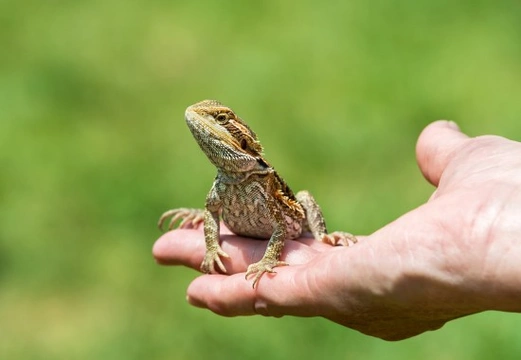
How to pick up and handle your pet lizard, and the best pet lizards for hands-on people
You may ask why you might need to handle a pet lizard, since lizards have no characteristic need to be picked up or shown affection, regardless of how carefully you may do it. Indeed, most reptiles won't (and can't) get used to being picked up. To a small lizard, being grabbed by someone big and intimidating will really scare them, and possibly convince them that they are about to meet their maker!
The main downside to handling lizards from the person’s point of view is that they might bite! Contingent upon the size and the type of lizard you are handling, being bitten may not hurt, or it may hurt a lot, and inflict potentially serious damage on you!
While it is not impossible to handle your pet lizard, it is worth bearing in mind that this does not prove beneficial to your pet, and may not be beneficial to you either. Also, you should always wash your hands completely every time you handle your lizard or work in its terrarium, to minimise the likelihood of contracting Salmonella, which is regularly passed on by reptiles to their handlers inadvertently.
Good and bad choices of lizards if you wish to handle your pet
There are a couple of reptiles that can and do become acclimated to physical handling, such as the Bearded Dragon and the Savannah Monitor. Both of these are easy to buy from exotic pet shops, and are usually reasonably priced too, as well as being popular with all sorts of keepers, both experienced and novice alike.
If being able to handle and pick up your lizard is really important to you, a Bearded Dragon is probably your best bet. Adult Bearded Dragons are vegetarians, and unlikely to get the taste or human skin! For tame Bearded Dragons that are used to being handled and are comfortable with it, they will often be quite happy to sit on a warm leg or arm and relax for a while, enjoying the heat of your skin.
Other lizards are a definite bad choice if you want to handle them, and the smaller of the lizard species are usually the ones that you should avoid picking up. The Day Gecko, for example, has incredibly fine, delicate skin that will tear easily if they are handled, particularly if they are frightened. This is part of the defence mechanism for the Day Gecko, as to them, it is preferable to lose some skin than to end up in the mouth of a predator!
Hints and tips for handling pet lizards
Sometimes, it is unavoidable to have to handle your lizard, or at least to make provision to move them from their enclosure to somewhere else. In this instance, there are some ways in which you can make handling them if necessary as stress-free and safe as possible.
Scooping up smaller lizards
It is possible to scoop your lizard up and hold its head gently but firmly between your thumb and finger. Alternately, you can scoop them up with one of its front legs between your thumb and index finger. They may struggle and wriggle around a bit, but they cannot get far while you still have hold of their leg! While they might possibly try to bite you, assuming that the lizard is small, this shouldn’t pose a problem.
Catch your lizard under a glass
Again for smaller lizards, you can catch them under a glass or other container, taking great care not to trap their limbs or tail. Then, slide something under the glass and lift it up.
Two hands for big lizards
Larger lizards, such as those over a foot long, will need to be handled with both hands to grasp them firmly and avoid harm. Many larger lizards have long, pointy claws that they might rake you with defensively, so it is important to bear this in mind and do what you can to prevent it!
Use one hand under the front legs, close to the body, and the other to secure the rear legs and tail. Take care not to drop your pet if they wriggle about, and try to plan picking them up so that you can move them as swiftly as possible.
Catch them in a pillowcase
Again for big lizards, you can effectively trap and move them without touching them by “herding” them into the open end of a pillowcase held open within their enclosure. Get the head in first, then shoo the lizard in or move the pillowcase back over them, then lift them out by holding the neck of the pillowcase and not the lizard!
Once you have them where you want them, open the pillowcase and allow them to walk back out.



